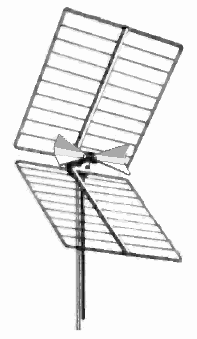Corner reflector antenna on:
[Wikipedia]
[Google]
[Amazon]
 A corner reflector antenna is a type of directional antenna used at VHF and UHF frequencies. It was invented by John D. Kraus in 1938.Kraus, John D., US patent 2270314
A corner reflector antenna is a type of directional antenna used at VHF and UHF frequencies. It was invented by John D. Kraus in 1938.Kraus, John D., US patent 2270314
Corner reflector antenna
filed January 31, 1940; granted January 20, 1942. It consists of a
 A corner reflector antenna is a type of directional antenna used at VHF and UHF frequencies. It was invented by John D. Kraus in 1938.Kraus, John D., US patent 2270314
A corner reflector antenna is a type of directional antenna used at VHF and UHF frequencies. It was invented by John D. Kraus in 1938.Kraus, John D., US patent 2270314Corner reflector antenna
filed January 31, 1940; granted January 20, 1942. It consists of a
dipole
In physics, a dipole () is an electromagnetic phenomenon which occurs in two ways:
*An electric dipole deals with the separation of the positive and negative electric charges found in any electromagnetic system. A simple example of this system ...
driven element
{{Unreferenced, date=April 2016
In a multielement antenna array (such as a Yagi–Uda antenna), the driven element or active element is the element in the antenna (typically a metal rod) which is electrically connected to the receiver or transmi ...
mounted in front of two flat rectangular reflecting screens joined at an angle, usually 90°. Corner reflector antennas have moderate gain of 10–15 dB, high front-to-back ratio
In telecommunication, the term front-to-back ratio (''also known as front-to-rear ratio'') can mean:
#The ratio of power gain between the front and rear of a directional antenna.
#Ratio of signal strength transmitted in a forward direction to that ...
of 20–30 dB, and wide bandwidth
Bandwidth commonly refers to:
* Bandwidth (signal processing) or ''analog bandwidth'', ''frequency bandwidth'', or ''radio bandwidth'', a measure of the width of a frequency range
* Bandwidth (computing), the rate of data transfer, bit rate or thr ...
.
Corner reflector antennas are widely used for UHF television receiving antennas, point-to-point communication links and data links for wireless WAN
Wireless wide area network (WWAN), is a form of wireless network.
The larger size of a wide area network compared to a local area network requires differences in technology.
Wireless networks of different sizes deliver data in the form of telephon ...
s, and amateur radio antennas on the 144, 420, and 1296 MHz bands. They radiate linearly polarized radio waves and can be mounted for either horizontal or vertical polarization.
The corner reflector ''antenna'' should not be confused with a '' corner reflector'', a passive device used to reflect radio waves back toward the source.
Physical design
The flat reflecting surfaces can be metal sheets, but are more often made of wire screen or rod elements parallel to the driven element, to reduce weight and wind loads on the antenna. The spacing of the rods ''D'' should not be more than 0.06 (6%) of thewavelength
In physics, the wavelength is the spatial period of a periodic wave—the distance over which the wave's shape repeats.
It is the distance between consecutive corresponding points of the same phase on the wave, such as two adjacent crests, t ...
. The angle ''θ'' between the sides is most commonly 90°. The gain increases as the angle narrows, but the increase below 90° is minimal, and requires longer reflector screens be used. However, angles down to 45° have been used.
The spacing ''(S)'' of the driven element in front of the point where the reflectors meet is approximately but is not very critical; for 90° antennas the gain doesn't vary more than 1.5 dB for ''S'' between and . The radiation resistance of the dipole increases with this spacing, so the spacing can be adjusted to match the driven element to the feed line. Bowtie driven elements are often used for wide bandwidth applications like television antennas.
The antenna can be regarded as a form with a gain intermediate between a plane reflective array antenna
In telecommunications and radar, a reflective array antenna is a class of directive antennas in which multiple driven elements are mounted in front of a flat surface designed to reflect the radio waves in a desired direction. They are a type o ...
and a parabolic antenna. Corner reflector antennas are particularly suitable in applications where a broadband directional antenna around one to wavelengths in size is needed. A parabolic dish this size has no advantage in gain over the corner reflector, so its simplicity of design and construction make it attractive.
Variations
Several different variations of the antenna are used *The single driven element can be replaced by a Yagi array. UHF Yagitelevision antenna
A television antenna (TV aerial) is an antenna specifically designed for use with a television receiver (TV) to receive over-the-air broadcast television signals from a television station. Television reception is dependent upon the antenna as ...
s very often use a corner reflector. These antennas actually function more like two separate antennas: the corner reflector and driven element serves to provide broad bandwidth gain at the lower end of the UHF band, while the Yagi array is cut to give extra gain at the high end of the band.
*Monopole versions for use at lower frequencies have been built by placing vertical reflecting screens behind a vertical monopole antenna
A monopole antenna is a class of radio antenna consisting of a straight rod-shaped conductor, often mounted perpendicularly over some type of conductive surface, called a ground plane.
The driving signal from the transmitter is applied, o ...
.
References
Further reading
* Technical article about the antenna by the inventor. {{Antenna_Types Radio frequency antenna types Antennas (radio)